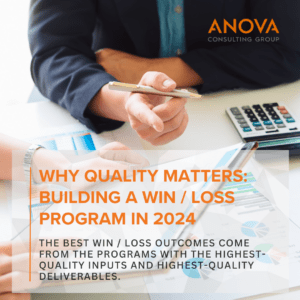
Thursday, June 13, 2024
 This blog was written by Andrew Cloutier, Partner at Anova.
This blog was written by Andrew Cloutier, Partner at Anova.
If It Sounds Too Good to Be True, It Probably Is. In general, teams are being asked to do more with less, both in terms of budget and FTEs. As such, the automation of processes is an important consideration in terms of cost and time savings.
The rise of automation and generative AI has created exciting opportunities across industries, including win / loss. While the potential of AI is undeniable, it’s important to approach it with a realistic mindset. An advanced AI model, no matter how sophisticated, cannot compensate for flawed data sources or poorly designed processes.
Practitioners of win / loss need to have a point of view and plan for taking advantage of automation and AI-driven opportunities, both for operational efficiency and insight generation purposes. But it is also important not to engage in “magical thinking” as it relates to the fundamental blocking and tackling of gathering and analyzing win / loss data. The most advanced generative AI model in the world is useless if its data source is faulty, and a fully automated survey process isn’t particularly helpful if the survey isn’t getting sent to the right people or generating meaningful responses. In short, if it sounds too good to be true, it probably is.
Qual Matters – High-Quality, Qualitative Feedback from Qualified Respondents
The best win / loss outcomes come from the programs with the highest-quality inputs and highest-quality deliverables.